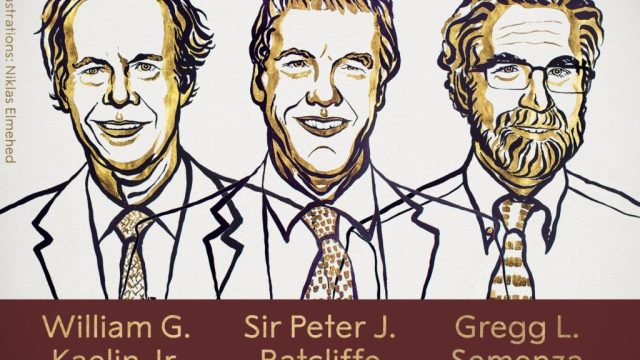Did Our Universe’s Structure Grow From The Top-Down Or From The Bottom-Up?
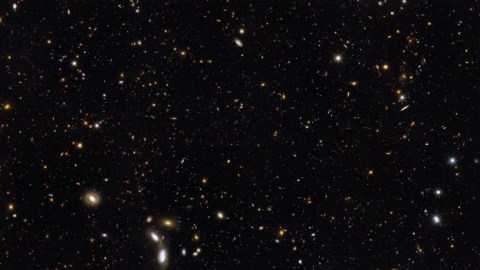
Or, quite possibly, is it more complex than either one of those scenarios?
If there’s one lesson that humanity should have learned from the 20th century, it’s this: the Universe rarely behaves the way our intuition leads us to suspect. At the start of the 1900s, we thought the Universe was governed by Newtonian gravity. We thought that the Universe was static, stationary, and infinitely old, with no beginning and no end. And we couldn’t even be sure whether the Milky Way was one of many galaxies, or whether it encompassed everything there was.
Of course, developments in both theory and observation changed all of this. Newtonian gravity was superseded by General Relativity, which demonstrated that a static Universe would be unstable. Spirals (and later ellipticals) were determined to be their own “island Universes” far outside of the Milky Way, each with billions of stars of their own. And instead of an infinitely old Universe, we live in one that got its start 13.8 billion years ago during the hot Big Bang. This picture itself was revolutionary, but led to a brand new question: how did the Universe grow up?
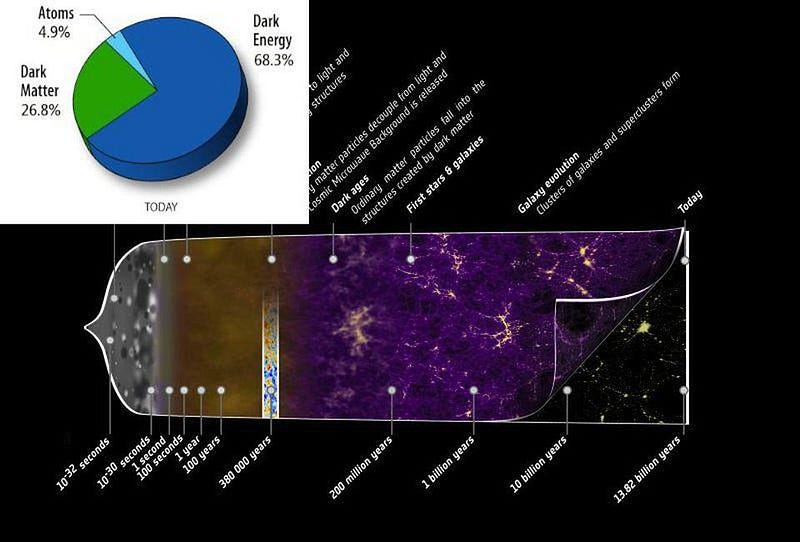
When we examine the Universe on the largest cosmic scales, we can begin mapping it out by identifying the properties and positions of every galaxy we’re capable of detecting. Thanks to our understanding of how light travels in an expanding Universe, we can accurately measure the redshift of a distant galaxy (i.e., how much its light gets stretched before arriving at our eyes) as well as, independently, how far away it is from us.
By combining both of these measurements, we can learn two important things:
- On average, the farther away a galaxy is from us, the greater its redshift appears to be.
- When you have large departures from the average density of the Universe, the local gravity field can induce extra speeds of hundreds or even thousands of km/s superimposed on top of the redshift given by the expanding Universe.
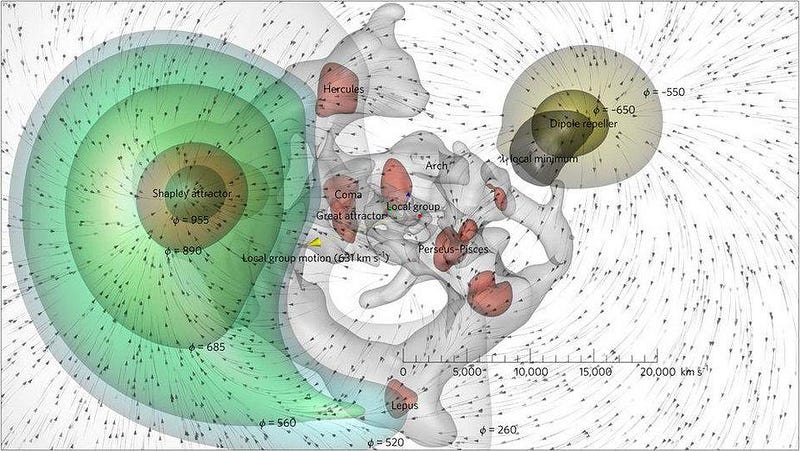
That second effect is known as peculiar velocity, since it describes the extra motion that stars, galaxies, or any mass experiences as being due to the gravitational effects of all the masses surrounding it. If we want to accurately map out the Universe, it becomes our duty to disentangle these two effects, to ensure that we’re assigning these galaxies their correct position in space, rather than the biased positions we’d infer from their measured redshifts.
Cosmologists — people like me who study the large-scale structure of the Universe — have known about these peculiar motions for a long time. If you map out where each galaxy is according to its redshift, you’ll find something unexpected: the map you make of the Universe will have galaxy filaments that all appear to point towards your location. Decades ago, cosmologists called this effect “Fingers of God,” because they all point at you no matter where you are. Fortunately, we immediately recognized that this is not a real, physical effect, but an effect of incorrectly analyzing our data.
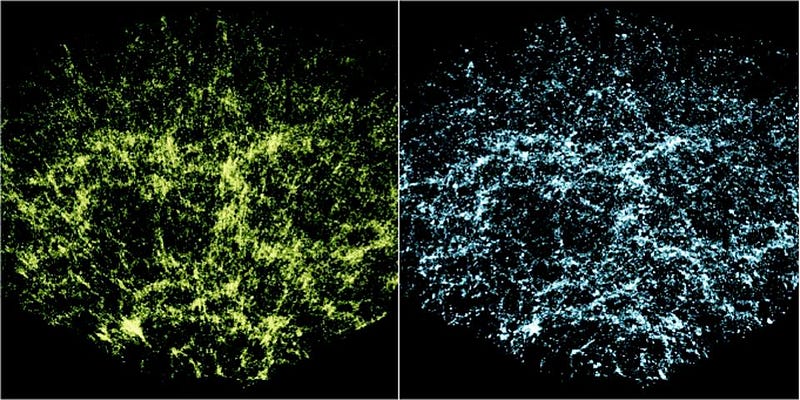
To understand how this is erroneous, we have to go all the way back to the beginning: to the earliest stages of the hot Big Bang. In these earliest stages, all the matter in the Universe — both normal matter and dark matter — was spread out almost perfectly evenly and uniformly. But that “almost” is of key importance; any tiny imperfections at early times are going to give rise to enormous imperfections at later times. The reason is simple and straightforward: gravity is a runaway force.
If you have a slight overdensity in your young Universe, it’s going to preferentially attract more and more matter towards it. Nearby regions of space that are lower in density will have their matter drawn into the higher density regions, leading to the growth and formation of galaxies, galactic groups and even enormous clusters of galaxies. These large-scale cosmic structures, as they grow and grow, can influence the motions of all the other massive objects around them.
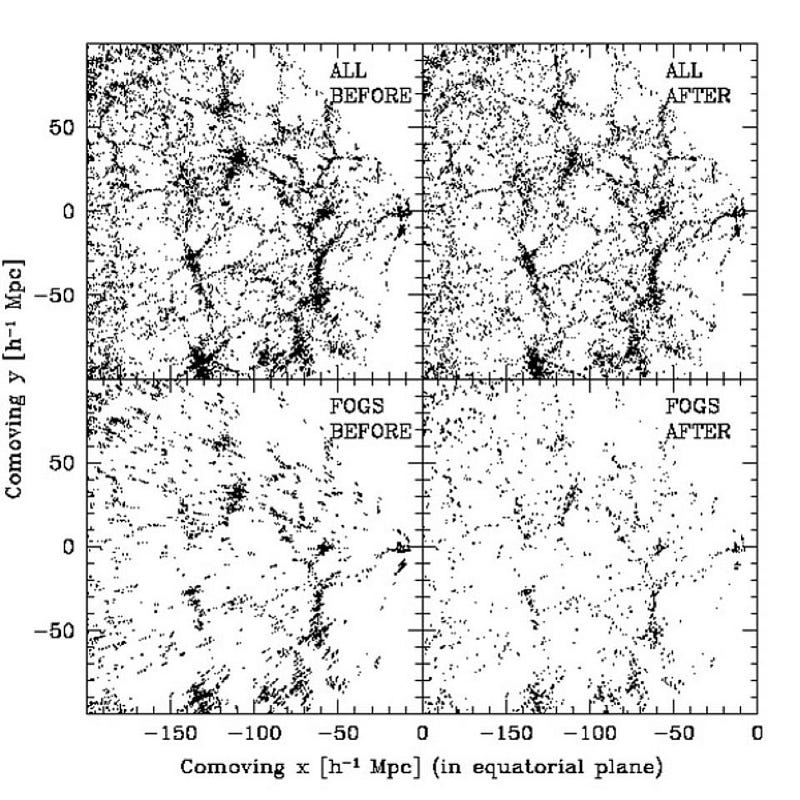
When we do successfully account for the observed motions of the galaxies we see today, we can perform corrections, and transform what we observe in “redshift-space” to what should actually be present in “real space.” Only by looking at the cosmic web with this undistorted view can we arrive at an accurate picture of how the Universe has clumped and clustered together on the largest scales.
The way that the Universe looks on the largest scales provides us with an enormous amount of information. Because we know how gravity works, we can use these observations to reconstruct two things together:
- What the Universe is made out of: dark energy (68%), dark matter (27%), normal matter (4.9%), neutrinos (0.1%) and radiation (0.01%).
- What the initial conditions of the Universe were: in what ways and by how much it departed from being perfectly uniform.
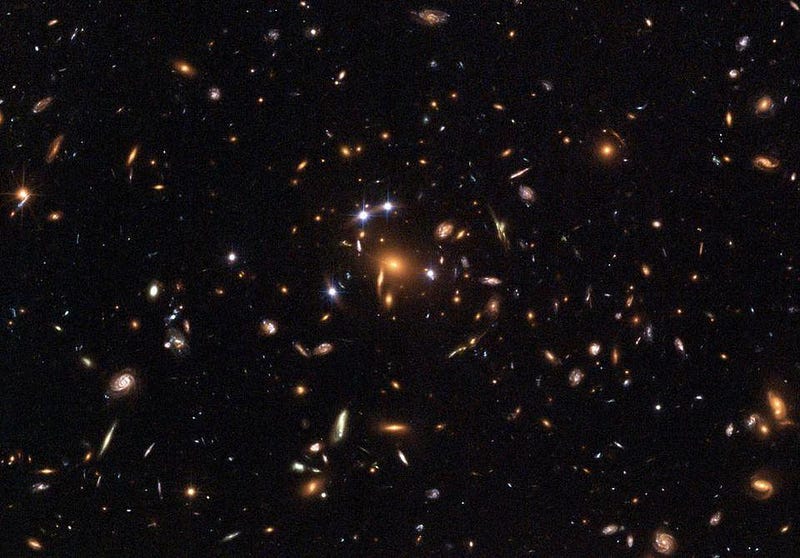
Many decades ago, before we had an array of space telescopes and deep, wide-field views of the distant Universe, all we had were theoretical possibilities to guide us. Even after we discovered the expanding Universe, the nature of distant galaxies, the radiation corresponding to the Cosmic Microwave Background and the ultimate validation of the Big Bang, we still didn’t know what the Universe was like when it first began.
The two possibilities for how our cosmic web came about are known as top-down or bottom-up scenarios. In a top-down Universe, the largest imperfections are on the largest scales; they begin gravitating first, and as they do, these large imperfections fragment into smaller ones. They’ll give rise to stars and galaxies, sure, but they’ll mostly be bound into larger, cluster-like structures, driven by the gravitational imperfections on large scales. A bottom-up Universe is the opposite, where gravitational imperfections dominate on smaller scales. Star clusters form first, followed later by galaxies and clusters, as small-scale imperfections experience runaway growth and eventually begin affecting larger scales.
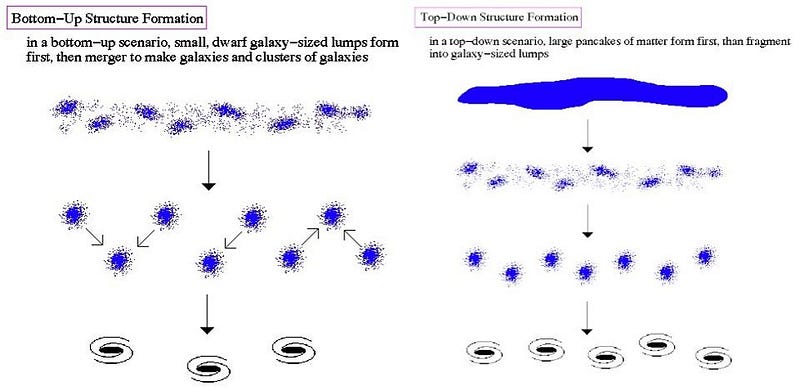
This tension between the two possibilities — top-down and bottom-op — permeated all aspects of cosmology throughout the 1960s, 70s and even well into the 80s and (for some) the 90s, too. As the data from galaxy surveys began to come in, mapping out the Universe in ever fainter, ever more distant, and ever more comprehensive chunks, astrophysicists got a bit of a surprise.
Whenever we find a galaxy, we can ask questions like, “what are the odds that I’ll find another galaxy a specific distance away from this one?” With enough galaxies mapped out, we can get that answer. We can also ask questions about finding three or more galaxies grouped together, as well as the odds of finding correlated galaxy pairs, quadruples, etc., on any scale at all.
When we put all of this data together, we can ask a decisive question: which scales contain the most clustering? By looking at a graph known as the Power Spectrum of the Universe, we can determine whether small-scales or large-scales dominate, or whether it’s a hybrid of the two.
In physics, we do our best work when our science is quantitative. When we can measure a parameter to high precision and with low uncertainty, we can draw the most powerful and informative conclusions about the nature of the Universe. For the question of top-down vs. bottom-up, the entity we want to look at is known as the scalar spectral index (ns), which is a measure of which scales contain the most power, initially, in the aftermath of the hot Big Bang.
- If n_s is a small number much lower than 1, the majority of the initial power will be on the largest scales rather than smaller ones, and we will live in a Universe that’s dominated by top-down rather than bottom-up processes.
- If n_s is a large number much bigger than 1, most of the initial power will occur on small scales, meaning we live in a Universe dominated by bottom-up rather than top-down processes.
- And if n_s = 1, this yields what we call a scale-invariant spectrum, meaning that power is evenly distributed (at least initially) on all scales, and only gravitational dynamics drive structure formation to get the Universe we see today.
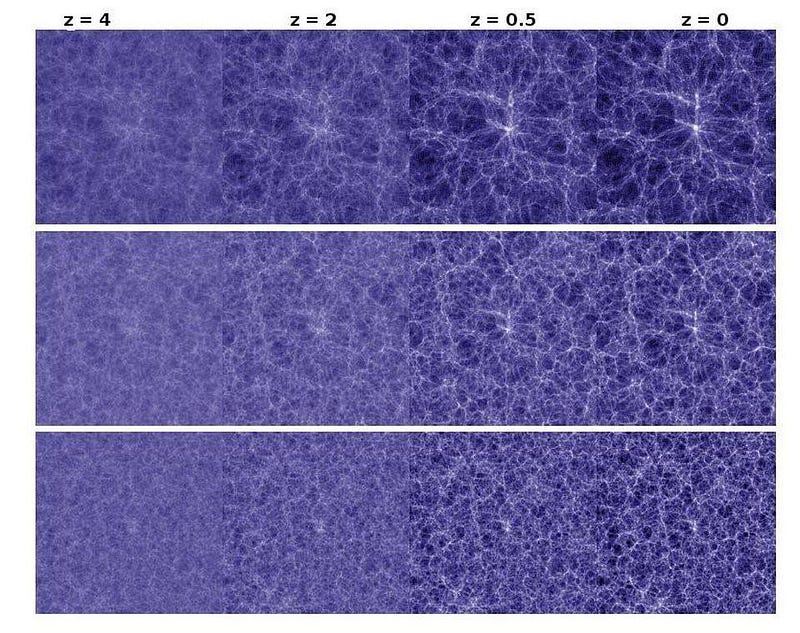
When the first major galaxy surveys started yielding meaningful results, we started to observe that the Universe was indistinguishable from scale-invariance, meaning that the Universe was not top-down and it wasn’t bottom-up; it was a combination of both. There are initial imperfections on small scales and large scales both, as well as the in-between scales. However, because gravitation only sends signals at the speed of light, the small scales begin to experience gravitational collapse before the larger scales can even begin to affect one another.
With the “seeds” of structure present on all scales, we fully anticipate the small scales to develop first, in tens or hundreds of millions of years, while the largest ones will take billions to fully form. Today, our best measurements of the Power Spectrum of the Universe and of the scalar spectral index, n_s, tells us that n_s = 0.965, with an uncertainty of less than 1%. The Universe is very close to scale-invariant, but it’s tilted to be just a little bit more top-down than bottom-up.
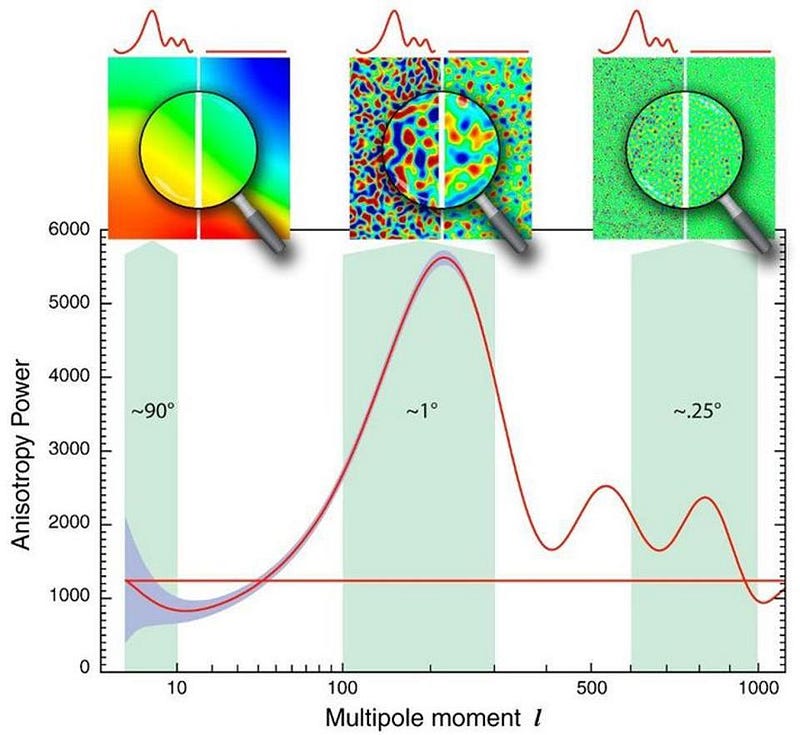
A century ago, we didn’t even know what our Universe looked like. We didn’t know where it came from, whether or when it began, how old it was, what it was made out of, whether it was expanding, what was present within it. Today, we have scientific answers to all of these questions to within about 1% accuracy, plus a whole lot more.
The Universe was born almost perfectly uniform, with 1-part-in-30,000 imperfections present on practically all scales. The largest cosmic scales have slightly larger imperfections than the smaller ones, but the smaller ones are also substantial and collapse first. We likely formed the first stars just 50-to-200 million years after the Big Bang; the first galaxies arose 200-to-550 million years after the Big Bang; the largest galaxy clusters took billions of years to get there.
The Universe is neither top-down nor bottom-up, but a combination of both that implies it was born with an almost scale-invariant spectrum. With future survey telescopes such as LSST, WFIRST, and the next-generation of 30-meter-class ground-based telescopes, we’re poised to measure galaxy clustering as never before. After a lifetime of uncertainty, we can finally give a scientific answer to understanding how our Universe’s large-scale structure came to be.
Ethan Siegel is the author of Beyond the Galaxy and Treknology. You can pre-order his third book, currently in development: the Encyclopaedia Cosmologica.





